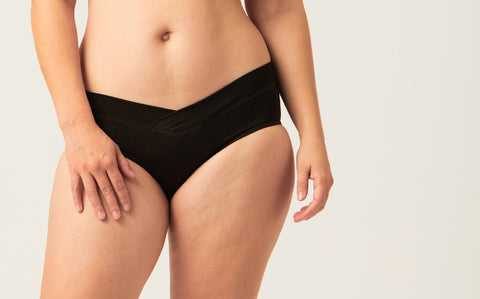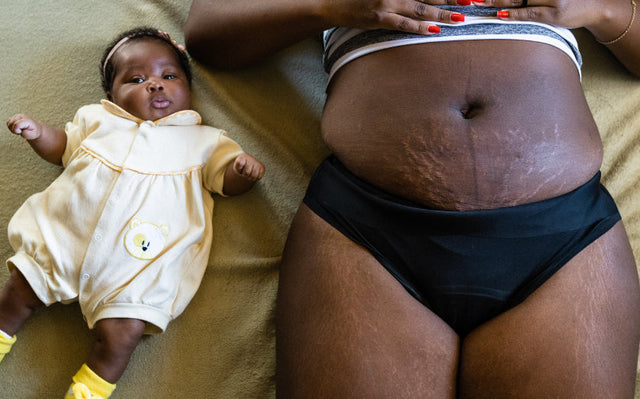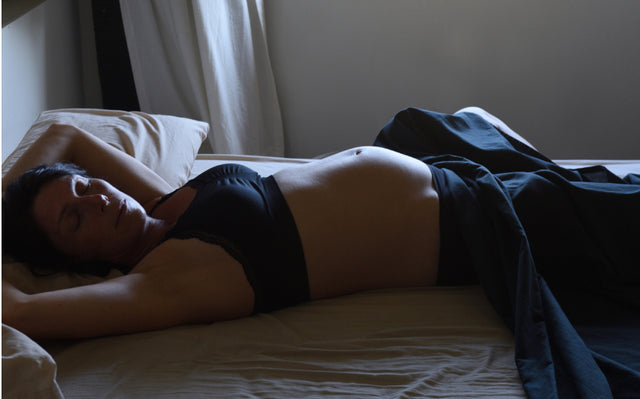The clots-and-all truth about how much you bleed, for how long, and what to do about...
Let’s talk about POSTPARTUM BLEEDING. Yep, giving birth is only the beginning.
And while you may have enjoyed not having a period for the past 9-ish months (pregnancy spotting and discharge aside), the postpartum period brings the bleeding back – often somewhat unexpectedly, and heavily.
Is vaginal bleeding normal after birth? And why does it happen?
Sure is, and it happens whether you give birth vaginally or via Caesarean section. During your pregnancy, blood vessels connect your placenta to your uterus. When the placenta comes away from the uterine wall after your baby is born, those blood vessels are open, and they bleed. Your uterus contracts to squeeze them shut over a period of up to 10 days, during which time the bleeding should slowly lessen.
How much postpartum bleeding will there be?
The amount does vary from person to person (maybe not the concrete answer you were looking for), but it’s typically not like a normal period (unless your flow is always super heavy).
During the first day or two after birth, the bleeding is usually bright or dark red and pretty heavy – as much as the equivalent of one sanitary pad per hour in the first 24 hours. Over the next few days, the bleeding should slowly reduce and change colour from bright red to a pink or brown, before eventually lightening to a creamy discharge colour over a few weeks.
Bleeding is often heavier in the morning when you get up (thanks gravity), after breastfeeding, or after exercising (if you’re feeling up to doing that in the first six weeks – and hey many of us aren’t).
One thing lots of people aren’t ready for is blood clots, sometimes lots of them and they can be quite large.
“In the early postpartum period, some women find when they get out of bed or have a shower there will be quite heavy blood loss or sometimes clots,” said midwife Hannah Willsmore.
How long does postpartum bleeding last?
For most people, postpartum bleeding will last up to six weeks after giving birth, but that’s not a given. Similarly, while for some, bleeding slowly tapers nicely according to expectations, for others it’s more of a stop/start affair, so just when you think it’s over, it starts up again.
“The first few days of postpartum bleeding is called lochia rubra, which is the heaviest bleeding. Between days 7 to 10 bleeding slows and transitions to the next phase, lochia serosa, which lasts until around day 14, is more pink or brown and should have much less clotting. From about week three, bleeding transitions into lochia alba and changes to more of a yellowish discharge, which can last for several weeks. This discharge consists mainly of white blood cells which are aiding the healing of the placental attachment to the uterine wall,” said naturopath and doula, Clare Eden.
Is it normal to pass blood clots after birth?
It is. A blood clot is basically a ‘mass’ of blood which sticks together and has a jelly-like consistency; and passing blood clots is perfectly normal after having a baby. Don’t be alarmed if you pass large clots in the first 24 hours after giving birth (we’re talking up to golf ball sized), they’ll usually become smaller and less frequent as the days go on. If you’re ever concerned, just ask your midwife, doula or doctor because it can be hard to know what’s ‘normal’, especially when you haven’t been through it before. And let’s face it, even if you have, no two births, or after-births are ever the same.
“Passing small clots during the first days after delivery is not unusual, and occasionally a larger clot may pass, but so long as everything settles down afterwards, this isn’t usually an issue. However, if you continue to have heavy bleeding and pass clots, you should be reviewed by a doctor, as this may be a sign of ‘retained products’, which means your placenta might not have completely come away from the uterine wall,” explained midwife, Karen Fiebig.
What happens if bleeding gets heavier – instead of lighter?
There are a few causes of increased bleeding in the postpartum period. One is if your uterus doesn’t contract properly to close off the blood vessels. Another is called retained placenta, which is when your placenta doesn’t come away in its entirety after birth, leaving some tissue still attached to the uterine wall, which prevents your uterus from contracting. If your vagina, cervix or uterus has been injured during birth, or if you have an infection, you might also experience excessive bleeding in the postpartum stage.
How do you know if your uterus is contracting normally?
This is something your midwife will usually check, by feeling your belly for the location of your fundus (the top of your uterus). As the uterus contracts, it gets smaller and is felt lower in your abdomen, and by 10 days after birth, it should have contracted enough to not feel it when pushing on your abdomen. It typically takes about six weeks for it to return to its original size – about as big as a closed fist. Ask your healthcare provider to show you if you’re at all concerned...or just curious.
What are afterpains – and how do you deal with them?
“This is something which takes plenty of people surprise postpartum. After giving birth, your uterus contracts back down to almost its pre-pregnancy size. These contractions can feel like mini labour contractions which can be quite painful, and it tends to get worse the more babies you have, so unfortunately, if you’ve had intense afterbirth pains with your first baby, you’re likely to get them again. I find hot showers and heat packs are the best options for relief, but if your pain is really bothering you, chat to your care providers about medical pain relief options,” advised midwife Hannah Willsmore.

When should you ask for your help?
First up, if you’re worried or just don’t feel right, don’t feel embarrassed or awkward about asking for help. Just do it.
Guidelines from Queensland Health advise calling your health care provider if, more than 24 hours after giving birth:
- The amount of bleeding suddenly/drastically increases or you pass larger clots
- Your bleeding changes from a pink/brown colour to a bright bed
- You feel dizzy, weak, sweaty, have a fever or have trouble breathing
- You pass blood which smells
- Your discharge has an offensive odour or unusual colour
How can Modibodi help?
Modibodi reusable underwear has a built-in lining which absorbs fluid – including postpartum bleeding and bladder leaks (if you win the post-birth lottery you’ll likely get both at once) - so you don’t need to use disposable, scratchy, bulky pads.
Our Maxi-24hrs technology, built into the gusset from the front to the back waistband is black (no stains) and absorbs up to 50ml of fluid. It’s also comfortable, breathable to fight odour and bacteria. Available in different styles to suit different bodies and sizes, this is the best choice for early postpartum bleeding.
We suggest you pack a few pairs into your hospital bag for those first few days so you’ll have a ready supply as depending on your flow, it’s hard to know exactly how long you’ll be able to wear each pair. Buy them in a bundle pack to save.
After that, you might want to move to our Heavy-Overnight absorbency, which has our absorbent lining up to the back waistband. As your bleeding decreases, our Moderate-Heavy absorbency and then Light-Moderate absorbency styles should do the trick.
Even once bleeding subsides, you might still find you experience occasional spotting, light bladder leaks from your weakened pelvic floor or an irregular cycle for a number of months, if not years. Many women choose to wear Modibodi leak-proof underwear for everyday comfort and back-up protection from unexpected leaks – just in case.
If you’re still pregnant, and just reading up on what to expect, our Maternity Brief is crafted from super soft fabric and sits under the hip with a V-shaped dip in the waistband. With its built-in absorbent gusset, it’s designed to absorb pregnancy discharge and leaks.
 Above: Modibodi Maternity Brief
Above: Modibodi Maternity Brief
NOTE: Hannah Willsmore’s advice was transcribed from her session on Tell Me Baby Live.
Disclaimer: Please note, Modibodi’s blog content is designed for educational and/or entertainment purposes, it is not official medical or healthcare advice. Please do not rely on this information as a substitute for professional medical advice, and always consult a doctor with any questions or concerns about your health.






